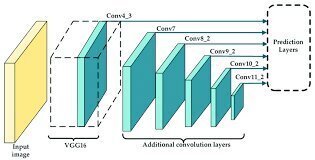Overview of SSD (Single Shot MultiBox Detector)
The Single Shot MultiBox Detector (SSD) is a powerful object detection framework that operates using a single deep neural network to simultaneously perform object localization and classification. This approach simplifies the detection process by eliminating the need for separate proposal generation, which is a common step in other methods like Faster R-CNN.
Architecture
SSD’s architecture is built upon the VGG-16 model, utilizing its convolutional layers while discarding the fully connected layers. This design allows SSD to leverage the feature extraction capabilities of VGG-16 while enabling the model to detect objects at multiple scales. The network generates a set of default bounding boxes with various aspect ratios and scales for each feature map location. During inference, SSD predicts the presence of object categories within these boxes and adjusts their dimensions to better fit the detected objects[1][5].
Key Features
-
Single Shot Detection: SSD processes images in a single forward pass, making it significantly faster than traditional methods that require multiple stages of processing.
-
MultiBox Approach: The MultiBox technique allows SSD to predict multiple bounding boxes for each object, improving detection accuracy for various object sizes and shapes.
-
Multiscale Feature Maps: By using feature maps from different layers, SSD can effectively detect objects of varying sizes. This multiscale strategy ensures that both small and large objects are accurately identified[2][4].
-
Non-Maximum Suppression (NMS): To refine the predictions, SSD employs NMS to eliminate redundant bounding boxes based on confidence scores, ensuring that only the most relevant detections are retained[2][3].
Performance
SSD has demonstrated impressive performance on standard object detection benchmarks, achieving a mean Average Precision (mAP) of over 74% on the PASCAL VOC dataset while maintaining a processing speed of 59 frames per second. This efficiency makes SSD suitable for real-time applications in various fields, including autonomous driving and video surveillance[1][2][5].
Conclusion
The Single Shot MultiBox Detector represents a significant advancement in the field of computer vision. Its ability to combine speed and accuracy in object detection tasks makes it a preferred choice for many real-time applications. The architecture’s reliance on deep learning techniques allows it to adapt and improve with advancements in neural network design and training methodologies[1][4].
Further Reading
1. [1512.02325] SSD: Single Shot MultiBox Detector
2. Understanding SSD MultiBox — Real-Time Object Detection In Deep Learning | by Eddie Forson | Towards Data Science
3. How single-shot detector (SSD) works? | ArcGIS API for Python
4. 14.7. Single Shot Multibox Detection — Dive into Deep Learning 1.0.3 documentation
5. https://www.cs.unc.edu/~wliu/papers/ssd.pdf


